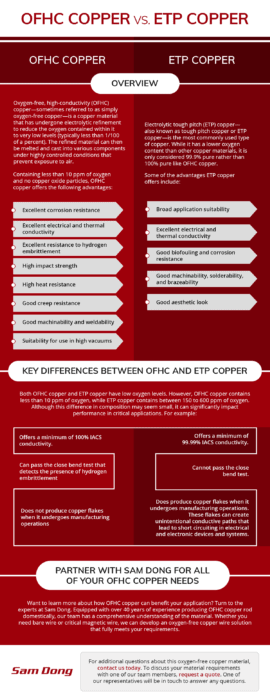Sam Dong is a domestic producer of oxygen-free, high-conductivity (OFHC) copper rod. We utilize it to produce strip, shapes, and a variety of copper wire products, including bare wires, continuously transported conductors (CTCs), paper-insulated rectangular wires, special insulated wires, and more. Below, we highlight how this material compares to electrolytic tough pitch (ETP) copper.
Overview of OFHC Copper
Oxygen-free, high-conductivity (OFHC) copper—sometimes referred to as simply oxygen-free copper—is a copper material that has undergone electrolytic refinement to reduce the oxygen contained within it to very low levels (typically less than 1/100 of a percent). The refined material can then be melted and cast into various components under highly controlled conditions that prevent exposure to air.
Containing less than 10 ppm of oxygen and no copper oxide particles, OFHC copper offers the following advantages:
- Excellent corrosion resistance
- Excellent electrical and thermal conductivity
- Excellent resistance to hydrogen embrittlement
- High impact strength
- High heat resistance
- Good creep resistance
- Good machinability and weldability
- Suitability for use in high vacuums
Overview of ETP Copper
Electrolytic tough pitch (ETP) copper—also known as tough pitch copper or ETP copper—is the most commonly used type of copper. While it has a lower oxygen content than other copper materials, it is only considered 99.9% pure rather than 100% pure like OFHC copper.
Some of the advantages ETP copper offers include:
- Broad application suitability
- Excellent electrical and thermal conductivity
- Good biofouling and corrosion resistance
- Good machinability, solderability, and brazeability
- Good aesthetic look
Key Differences Between OFHC and ETP Copper
Both OFHC copper and ETP copper have low oxygen levels. However, OFHC copper contains less than 10 ppm of oxygen, while ETP copper contains between 150 to 600 ppm of oxygen. Although this difference in composition may seem small, it can significantly impact performance in critical applications. For example:
- OFHC copper offers a minimum of 100% IACS conductivity, while ETH copper offers a minimum of 99.99% IACS conductivity.
- OFHC copper can pass the close bend test that detects the presence of hydrogen embrittlement, while ETH copper cannot pass the close bend test.
- OFHC copper does not produce copper flakes when it undergoes manufacturing operations, while ETH copper does produce copper flakes when it undergoes manufacturing operations. These flakes can create unintentional conductive paths that lead to short circuiting in electrical and electronic devices and systems.
The slightly higher conductivity of OFHC copper can be highly beneficial to a wide range of industries. For example, using OFHC copper over ETH copper to produce wires for transformers can reduce the overall diameter of the wire needed to achieve a certain efficiency. As a result, the amount of wire material required and, consequently, the overall cost of materials are reduced. The smaller size of the conductors also means manufacturers can make the overall transformer unit smaller, further reducing material costs.
Partner With Sam Dong for All of Your OFHC Copper Needs
Want to learn more about how OFHC copper can benefit your application? Turn to the experts at Sam Dong. Equipped with over 40 years of experience producing OFHC copper rod domestically, our team has a comprehensive understanding of the material. Whether you need bare wire or critical magnetic wire, we can develop an oxygen-free copper wire solution that fully meets your requirements.
For additional questions about this oxygen-free copper material, contact us today. To discuss your material requirements with one of our team members, request a quote. One of our representatives will be in touch to answer any questions.

